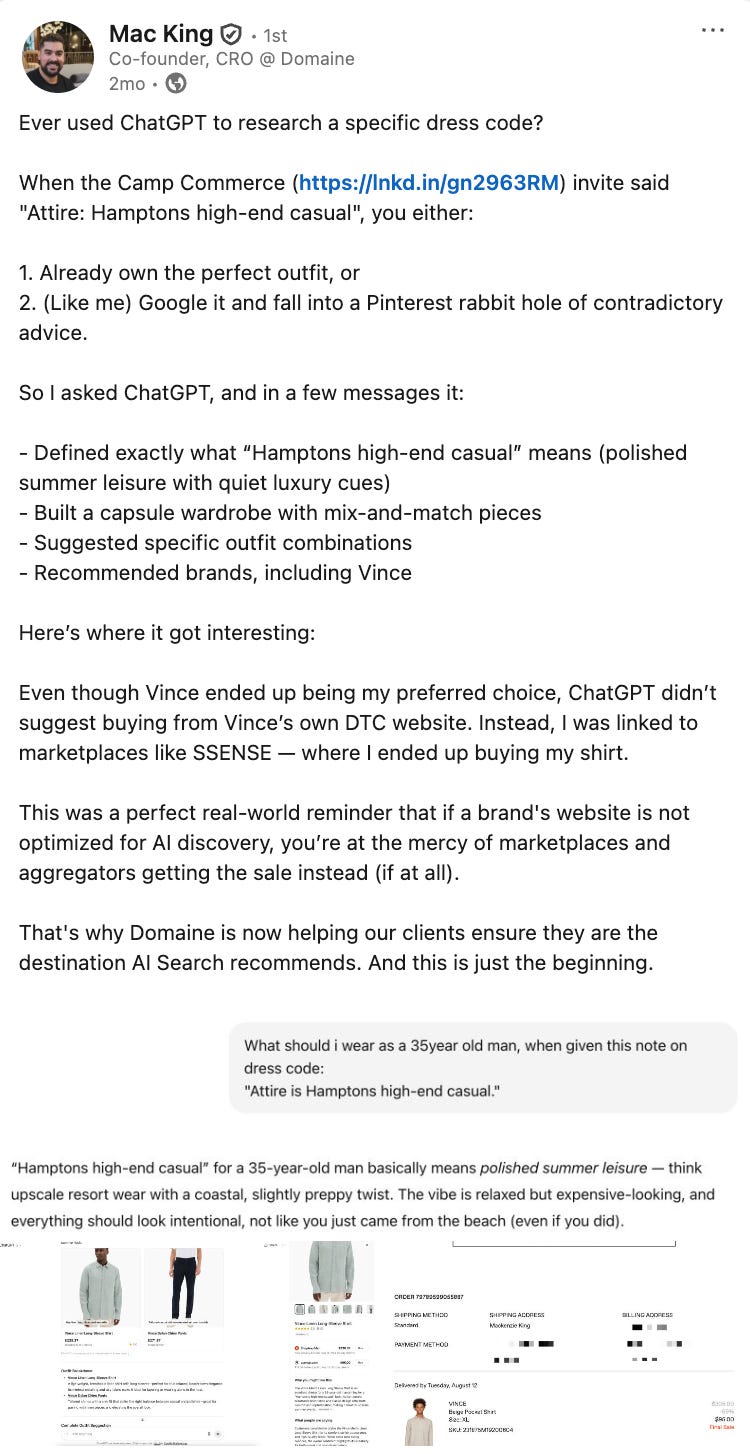The biggest shift in online shopping since Google
Practical ways to show up when your customers search
Hi team,
It’s been a hectic week. Happy Sukkot to those celebrating. We’re back home from our Portugal adventure, yet still jet-lagged. Noah is still on Lisbon time. It’s going great.
This week, I want to talk about something I’ve somehow avoided writing about, even though it’s already changing how people shop.
If you check your analytics right now, there’s a decent chance you’ll see visits showing up with “ChatGPT” as the source. It’s still small. But it’s growing fast.
People aren’t searching the way they used to. They’re asking. When someone types “best cleanser for dry skin” into ChatGPT or Claude, they aren’t scrolling through a dozen links. They’re getting an answer with specific products, reviews, and retailers without ever touching Google or Amazon.
That behavior shift might sound subtle, but it’s already rewriting how brands get discovered. For years, we’ve optimized for search engines with SEO. Now we’re learning how to show up in conversations.
So this week, I want to break down what’s actually happening. Is this just SEO with a new coat of paint, or are we dealing with something closer to a black box where no one fully understands why one brand shows up and another doesn’t?
I’ll try to keep it pretty practical so you can make some moves today.
Let’s jump in.
This week’s newsie is brought to you by Gorgias!
BFCM isn’t a race to the biggest discounts anymore — it’s a race to deliver the best experience.
In 2025, shoppers expect instant, personalized, and on-brand conversations that solve problems and inspire purchases. The brands that win will be the ones that turn every conversation into an opportunity to convert.
Join Gorgias CX experts and top ecommerce leaders on October 28 for a live tactical session on how to use AI-driven conversations to transform your helpdesk into a profit center — automating responses, guiding pre-sale decisions, and driving conversions at scale.
Plus! Get early access to the Gorgias BFCM Checklist and Playbook. This will be your blueprint to scaling efficiently, maximizing conversions, and keeping your CX team energized through peak season.
Is this SEO 2.0 or a black box?
A few weeks ago, Mac King, CRO at Domaine, shared a post that perfectly sums up how fast things are shifting.
He asked ChatGPT what to wear to an event with the dress code “Hamptons high-end casual.” ChatGPT described the vibe, built an outfit, listed items, and recommended brands. One of them was Vince.
But when Mac asked where to buy the shirt, ChatGPT didn’t send him to Vince.com. It sent him to SSENSE. And that’s where he bought it.
Vince didn’t do anything wrong, per se. They have a clean site, a strong brand, and a loyal audience. But when AI decides who gets surfaced, the question isn’t always about having the best logo or ad budget. It’s who the model trusts to deliver accurate, detailed, and well-structured data. SSENSE had that. Vince didn’t.
That single interaction is what’s happening everywhere right now. AI is turning product discovery into a trust exercise between data sources. The model decides which brands deserve to appear in an answer based on a messy blend of product information, sentiment, and off-site validation. And unlike SEO, there’s not yet a dashboard showing what helped or hurt you.
If Google search was about climbing a ladder of keywords and backlinks, this new era feels more like a black box with constantly shifting walls. You can’t see how it’s weighing anything, but you can feel it working.
The irony is that brands are finally doing everything they were told to do. Great creative. Clean site experience. High-quality photography. It all still matters, but it’s no longer enough. The algorithm doesn’t care if your PDP looks beautiful if it can’t read your schema or validate your data elsewhere.
We’ve entered the part of the movie where being “technically correct” wins...
What actually makes Patagonia show up over Gymshark
A few years ago, Gymshark looked untouchable. It flooded Instagram with creators and built a community so strong that other brands tried to copy its playbook. Patagonia, meanwhile, felt like the quiet older sibling. Dependable, respected, but hardly dominating the cultural feed as much.
Fast forward to now, and that dynamic has flipped. In the world of AI discovery, Patagonia is taking the lead. When shoppers ask ChatGPT or Perplexity for recommendations on outdoor clothing and gear, Patagonia appears in 94% of the answers. Gymshark, which used to lead on cultural relevance, barely shows up.
The referral data makes the shift even clearer. Over the past twelve months, traffic from ChatGPT to Gymshark’s site has dropped from 94% to just over 50%. Patagonia has climbed from 6% to 46%. The gap closed because AI started rewarding something completely different from what used to drive discovery.
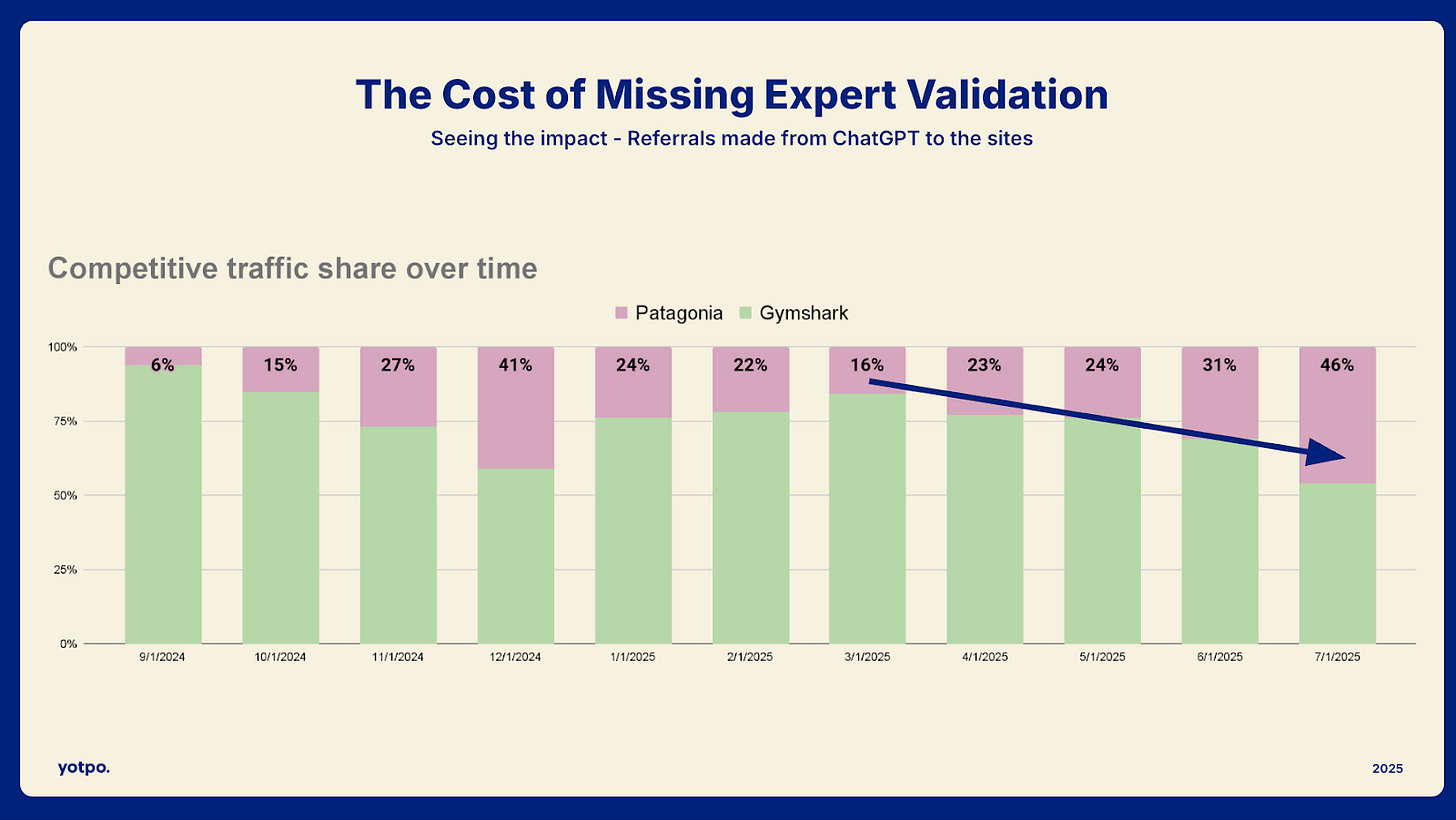
According to Yotpo CEO Tomer Tagrin, that trust primarily comes down to three things:
Brand data: Patagonia’s site includes detailed product specs, material information, sustainability details, and clean structured data. It’s built for machines to understand. Gymshark’s site is visually sharp but relies heavily on creative assets and copy that are harder for AI models to interpret.
User sentiment: Patagonia’s reviews are long and descriptive. Customers talk about where they hike, how the jacket performs in wind, and what temperatures they wore it in. Those specifics give models something to connect to. Gymshark’s reviews are enthusiastic but short, which limits how much useful information the system can pull from them.
Expert validation: Patagonia has deep coverage from trusted publications like Outside Magazine, Runner’s World, and Consumer Reports. Gymshark’s coverage is mostly influencer-driven and lifestyle-focused. That kind of attention helps with awareness but doesn’t signal authority to a model that prioritizes objective proof.
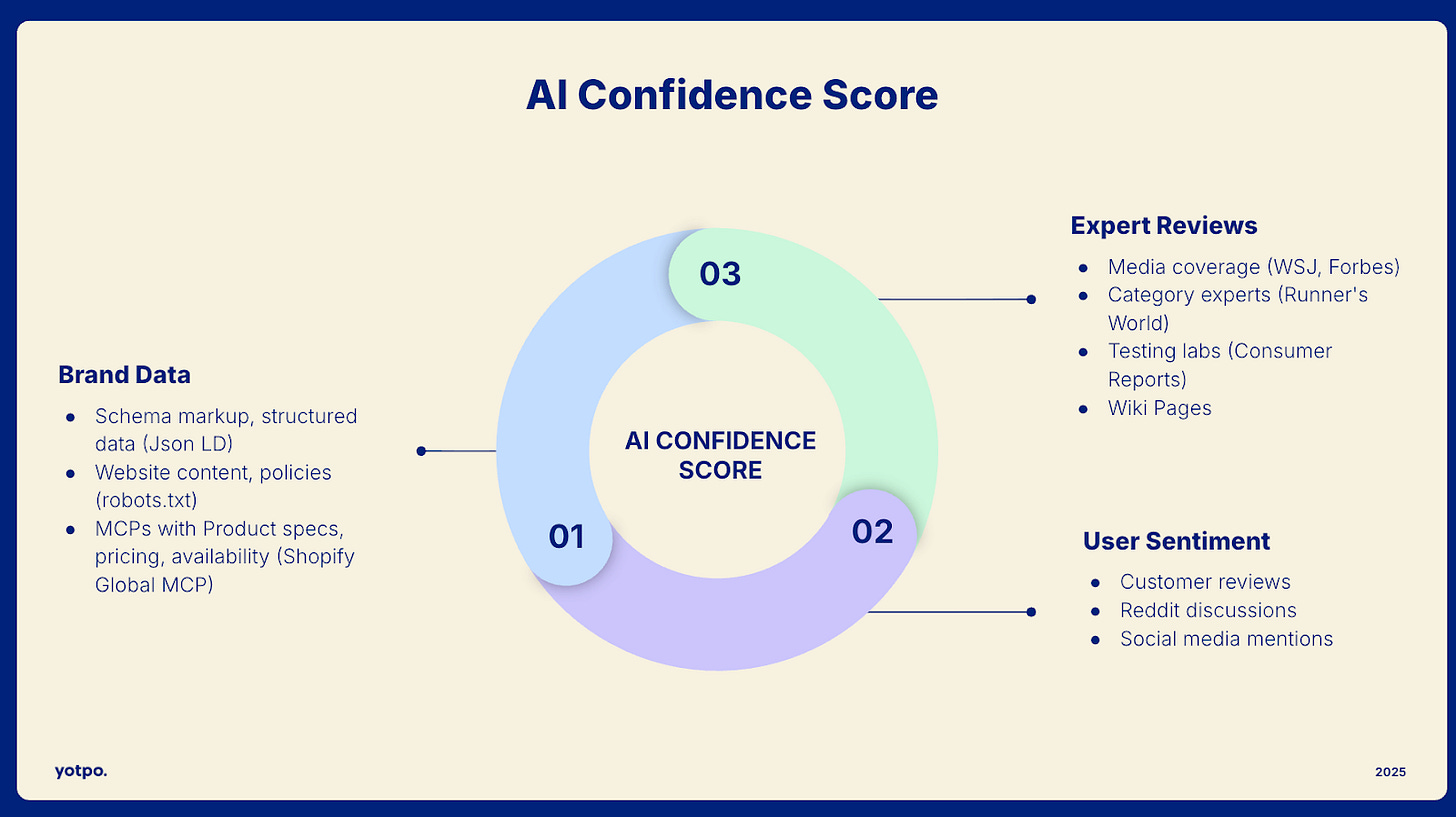
Together, these three factors form what Tomer calls the AI Confidence Score. It’s a way of measuring how likely an AI model is to trust your brand enough to include it in an answer.
FYI: Tomer has been researching this shift in depth and writing about it in his newsletter, CommerceGPT.xyz, which is already being read by more than 5,000 marketers trying to stay ahead of the AI discovery curve.
The comparison makes the new landscape clear. Popularity and content volume used to win. Now, clarity, structure, and verifiable proof do.
The Practical Playbook
So what do you actually do with all this? You start by assuming that most of your brand visibility no longer happens on your own site.
Our data shows that roughly 70% of AI citations now come from off-site sources: forums, media, review hubs, Reddit threads, and Wikipedia pages.
Only 30% come from brand-owned properties. That means your next “SEO strategy” isn’t just about optimizing your blog or PDPs. It’s about strengthening every place your brand gets mentioned, linked, or validated.
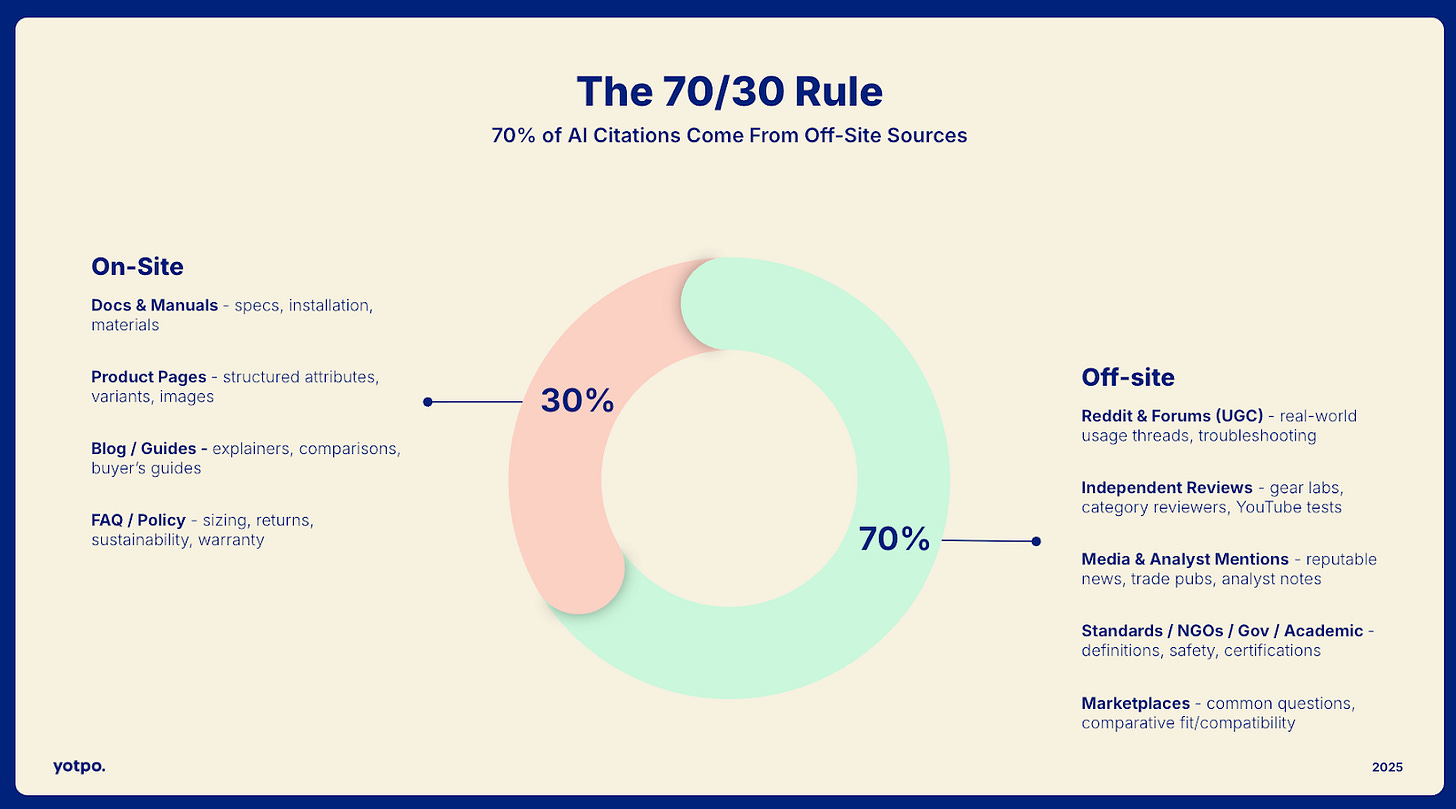
Once you accept that, three priorities emerge:
1. Structure your data.
Clean schema, feeds, and metadata are the new keywords. AI engines can’t recommend what they can’t read. If you’re not already pushing structured data into Google Merchant, Amazon, and review feeds, you’re invisible in half the new search ecosystem.
2. Cultivate expert validation.
That doesn’t mean chasing glossy press hits. It means getting cited in credible publications, product roundups, and certification lists that AI trusts. Think “Consumer Reports,” not “influencer shoutouts.”
3. Amplify user-generated proof.
Descriptive, authentic reviews are gold. The more your customers write like real humans, like, “I wore this on a 10-mile hike in 40° weather,” the more surface area you give AI to work with.
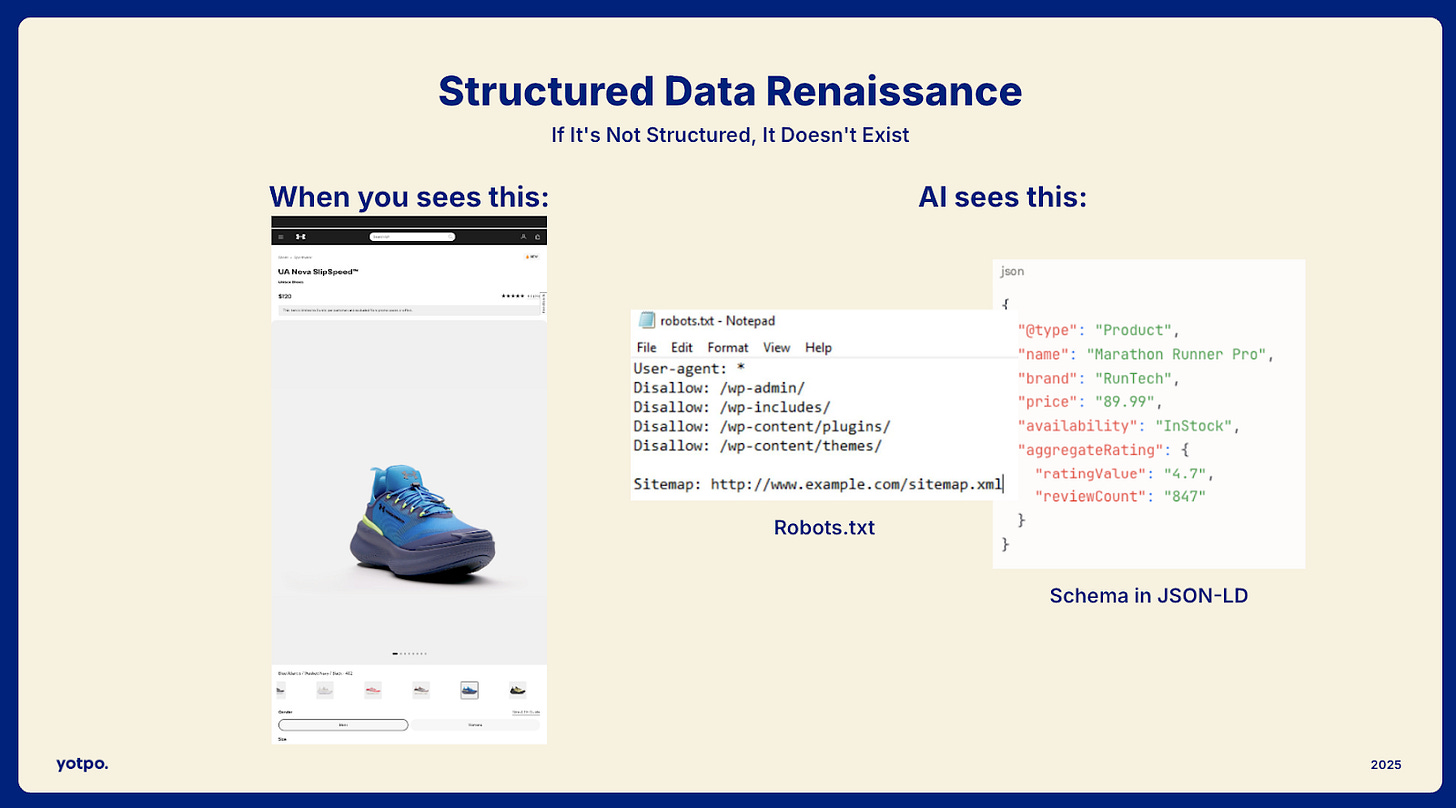
None of this is glamorous. It’s not the next viral TikTok trend. But it’s how you stay visible when buyers stop searching the way they used to.
Shameless plug: At Yotpo, we have been developing lots of tools to make sure your reviews show up structured the right way, such as smart prompts, AI review summary, etc.
Learn more about the future of shopping
Over the next few weeks, I’ll be hosting AI Uncensored, a set of small, operator-first, IRL gatherings focused on how brands are showing up in ChatGPT answers, what “prompt share” actually looks like, and how to build for AI discovery and the brave new world :)
We’ve got sessions in Miami (Oct 21) and Austin (Oct 23), plus a virtual roundtable for anyone who can’t make it in person.
And if you want to go deeper before then, check out CommerceGPT.xyz, where Yotpo CEO Tomer Tagrin breaks down how AI is reshaping eCommerce discovery each week.
That’s it for this week!
Any topics you’d like to see me cover in the future?
Just shoot me a DM or an email!
Cheers,
Eli 💛






